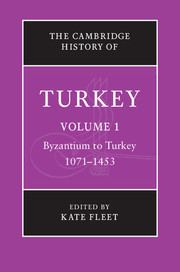Book contents
- Frontmatter
- 1 Introduction
- 2 The Byzantine Empire from the eleventh to the fifteenth century
- 3 Anatolia under the Mongols
- 4 Anatolia, 1300–1451
- 5 The incorporation of the Balkans into the Ottoman Empire, 1353–1453
- 6 Ottoman warfare, 1300–1453
- 7 The Turkish economy, 1071–1453
- 8 Art and architecture, 1300–1453
- 9 Social, cultural and intellectual life, 1071–1453
- Glossary
- Bibliography
- Index
- References
3 - Anatolia under the Mongols
Published online by Cambridge University Press: 28 March 2010
- Frontmatter
- 1 Introduction
- 2 The Byzantine Empire from the eleventh to the fifteenth century
- 3 Anatolia under the Mongols
- 4 Anatolia, 1300–1451
- 5 The incorporation of the Balkans into the Ottoman Empire, 1353–1453
- 6 Ottoman warfare, 1300–1453
- 7 The Turkish economy, 1071–1453
- 8 Art and architecture, 1300–1453
- 9 Social, cultural and intellectual life, 1071–1453
- Glossary
- Bibliography
- Index
- References
Summary
The period of Mongol rule in Anatolia, that is, roughly the century between the battle of Kösedağ in 1243 and the collapse of the Ilkhanid regime in the 1340s, if mentioned at all, is generally treated only as a brief preamble to the rise of the Ottomans. Even then, as in the nationalist histories of Russia and China, Mongol rule is seen as an unwelcome interlude that wrecked the country and left no formative traces. Rather, traditional Ottoman Turkish history arises seamlessly out of the history of the Seljuks of Rum, the principal, though latterly only notional, rulers of central Anatolia between their victory over the Byzantines at Malazgirt (Manzikert) in 1071 and their obscure demise in the early fourteenth century. By this time, one of the beyliks that was later the kernel of the Ottoman state was already in existence, among numerous others. According to Kafesoğlu, for example, this beylik ‘on the western frontier of the Seljuk state (sic), with regard to itsmoral fibre and organization, acquired many values from Seljuk Turkishness’ and ‘kept Anatolia as a Turkish motherland’. At the other end of the spectrum, comparisons have been drawn between the formation and development of the Mongol and Ottoman empires, with no reference at all to the Mongols in Anatolia.
Others have been ready to examine in more detail late thirteenth- and fourteenth-century Anatolian society, in which the Ilkhanate was the dominant power. Numismatists in particular have recently taken another look at the traditional view, and have emphasised the continuity of Ottomanfrom Ilkhanid practices. Yet here too, interest in the Mongols arises solely in connection with the circumstances in which the Ottoman state emerged. It is difficult, with hindsight, to look at the Mongol period without regard to later Turkish history.
- Type
- Chapter
- Information
- The Cambridge History of Turkey , pp. 51 - 101Publisher: Cambridge University PressPrint publication year: 2009
References
- 15
- Cited by

